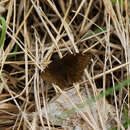Conservation Status
provided by University of Alberta Museums
Not of conservation concern.
- license
- cc-by-nc
- copyright
- University of Alberta Museums
Cyclicity
provided by University of Alberta Museums
Adults are most often encountered in mid to late June. One brood annually.
- license
- cc-by-nc
- copyright
- University of Alberta Museums
Distribution
provided by University of Alberta Museums
Occurs throughout most of temperate North America, north to the Alberta / NWT border. Restricted to watercourses in the drier parts of the Great Plains (Opler 1999).
- license
- cc-by-nc
- copyright
- University of Alberta Museums
General Description
provided by University of Alberta Museums
A relative large skipper (wingspan 28 to 38mm) that is most similar to our duskywing skippers (Erynnis spp.), but the Northern Cloudywing has even, dark brown forewing uppersides, not mottled like the duskywings. The sharply curved-back antennal clubs will also distinguish this species.
- license
- cc-by-nc
- copyright
- University of Alberta Museums
Habitat
provided by University of Alberta Museums
Clearings and meadows in pine and aspen woodlands, valley bottoms in the prairies.
- license
- cc-by-nc
- copyright
- University of Alberta Museums
Life Cycle
provided by University of Alberta Museums
The eggs are pale green (Bird et al. 1995), and larvae are dark green with a brownish ventral line and paler lateral lines (Layberry et al. 1998). The mature larvae feed and overwinter in shelters made from the host plant leaves (Layberry et al. 1998). Males exhibit perching behaviour to await females, and will chase off other butterflies entering their territory (McCabe & Post 1977, Acorn 1993).
- license
- cc-by-nc
- copyright
- University of Alberta Museums
Trophic Strategy
provided by University of Alberta Museums
The larval hostplant in Alberta is unrecorded. Elsewhere, this species feeds on various herbaceous legumes such as vetches and clovers (Hooper 1973, Opler 1999). Adults nectar at legume flowers such as vetch, alfalfa (Hooper 1973) and locoweed (McCabe & Post 1977). Adults sip moisture at damp earth (Bird et al. 1995).
- license
- cc-by-nc
- copyright
- University of Alberta Museums
Thorybes pylades
(
Dutch; Flemish
)
provided by wikipedia NL
Insecten Thorybes pylades is een vlinder uit de familie van de dikkopjes (Hesperiidae).[1] De wetenschappelijke naam van de soort is voor het eerst geldig gepubliceerd in 1870 door Samuel Hubbard Scudder.
Bronnen, noten en/of referenties Geplaatst op:
02-04-2013
Dit artikel is een beginnetje over biologie. U wordt uitgenodigd om op bewerken te klikken om uw kennis aan dit artikel toe te voegen.

- license
- cc-by-sa-3.0
- copyright
- Wikipedia-auteurs en -editors
Thorybes pylades
(
Vietnamese
)
provided by wikipedia VI
- license
- cc-by-sa-3.0
- copyright
- Wikipedia tác giả và biên tập viên
Thorybes pylades: Brief Summary
(
Vietnamese
)
provided by wikipedia VI
Northern Cloudywing là một loài bướm trong họ Bướm nhảy.
- license
- cc-by-sa-3.0
- copyright
- Wikipedia tác giả và biên tập viên


Phương tiện liên quan tới Thorybes pylades tại Wikimedia Commons